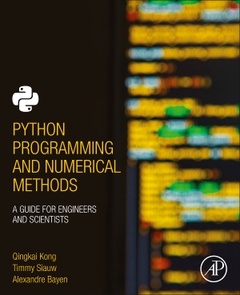Python Programming and Numerical Methods A Guide for Engineers and Scientists
Auteurs : Kong Qingkai, Siauw Timmy, Bayen Alexandre

PART 1 INTRODUCTION TO PYTHON PROGRAMMING
CHAPTER 1 Python Basics
CHAPTER 2 Variables and Basic Data Structures
CHAPTER 3 Functions
CHAPTER 4 Branching Statements
CHAPTER 5 Iteration
CHAPTER 7 Object-Oriented Programming CHAPTER 8 Complexity
CHAPTER 9 Representation of Numbers
CHAPTER 10 Errors, Good Programming Practices, and Debugging
CHAPTER 11 Reading and Writing Data
CHAPTER 12 Visualization and Plotting
CHAPTER 13 Parallelize Your Python
PART 2 INTRODUCTION TO NUMERICAL METHODS
CHAPTER 14 Linear Algebra and Systems of Linear Equations
CHAPTER 15 Eigenvalues and Eigenvectors
CHAPTER 16 Least Squares Regression
CHAPTER 17 Interpolation
CHAPTER 18 Taylor Series
CHAPTER 19 Root Finding
CHAPTER 20 Numerical Differentiation
CHAPTER 21 Numerical Integration
CHAPTER 22 Ordinary Differential Equations (ODEs) Initial-Value Problems
CHAPTER 23 Boundary-Value Problems for Ordinary Differential Equations (ODEs)
CHAPTER 24 Fourier Transform
Alexandre Bayen is the Liao-Cho Professor of Engineering at UC Berkeley. He is a Professor of Electrical Engineering and Computer Science, and Civil and Environmental Engineering. He is currently the Director of the Institute of Transportation Studies (ITS). He is also a Faculty Scientist in Mechanical Engineering, at the Lawrence Berkeley National Laboratory (LBNL). He received the Engineering Degree in applied mathematics from the Ecole Polytechnique, France, in 1998, the M.S. and Ph.D. in aeronautics and astronautics from Stanford University in 1998 and 1999 respectively. He was a Visiting Researcher at NASA Ames Research Center from 2000 to 2003. Between January 2004 and December 2004, he worked as the Research Director of the Autonomous Navigation Laboratory at the Laboratoire de Recherches Balistiques et Aerodynamiques, (Ministere de la Defense, Vernon, France), where he holds the rank of Major. He has been on the faculty at UC Berkeley since 2005. Bayen has authored two books and over 200 articles in peer reviewed journals and conferences. He is the recipient of the Ballhaus Award from Stanford University, 2004, of the CAREER award from the National Science Foundation, 2009 and he is a NASA Top 10 Innovators on Water Sustainability, 2010. His projects Mobile Century and Mobile Millennium received the 2008 Best of ITS Award for ‘Best Innovative Practice’, at the ITS World Congress and a TRANNY Award from the California Transportation Foundation, 2009. Mobile Millennium has been featured more than 200 times in the media, including TV channels and radio stations (CBS, NBC, ABC, CNET, NPR, KGO, the BBC), and in the popular press
- Includes tips, warnings and "try this" features within each chapter to help the reader develop good programming practice
- Summaries at the end of each chapter allow for quick access to important information
- Includes code in Jupyter notebook format that can be directly run online
Date de parution : 12-2020
Ouvrage de 480 p.
19x23.3 cm
Thèmes de Python Programming and Numerical Methods :
Mots-clés :
2D plot; 3D plot; bisection method; boundary value problem; branching statements; class; comprehensions; cubic spline; DFT; eigenvalues; eigenvectors; Euler method; FFT; finite difference method; functions; global variables; initial value problem; interpolation; iteration; joblib; Jupyter notebook; Lagrange polynomial; lambda functions; least squares regression; local variables; logical expressions; logical operators; maps; multiprocessing; nested functions; Newton–Raphson method; Newton"s polynomial interpolation; nonlinear functions; number representation; numerical integration; object; object-oriented programming; packages; parallel computing; power method; Predictor–Corrector; Python setup; QR method; reading files; Riemann integral; root finding; round-off errors; Runge–Kutta method; shooting method; Simpson rule; Taylor series; ternary operators; trapezoid rule; truncation error; writing files



